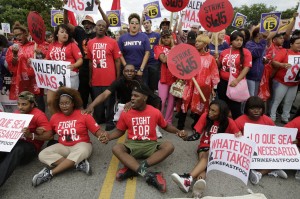
“I’m not going to support (a minimum wage) that absolutely puts people out of work. It just doesn’t make sense,” Pat Toomey, a Republican senator from Pennsylvania, said.
That type of sentiment forms much of the rationale behind the House’s continual blocking of raises in the national minimum wage. Although individual cities and states — including Illinois, which will be holding a non-binding referendum in November — are putting the issue to their own state ballots, Washington has made its stance clear.
Basic economic theory seems to support this sentiment. A minimum wage is, supposedly, a measure that raises the price of labor higher than what the free market would dictate the wage should be. Employers generally only employ workers up to the point where the extra worker’s presence in the business provides profit beyond what their wage dictates; that is, a ninth worker at the local Jimmy John’s will only be employed if his presence allows the business to sell at least $8.25 more worth of sandwiches per hour.
Orthodox theory would thus say that if the minimum wage were raised up to, say, $10 per hour, that worker who formerly provided $8.25 of extra value in sales would no longer be hired. This economy-wide effect would thus supposedly kill thousands of jobs, with the Congressional Budget Office (CBO) predicting that a $10.10 national minimum wage could possibly kill 500,000 jobs.
“The thing that is an issue is that we often incorrectly assume the idea of perfectly competitive markets,” Laura Owen, a professor of labor economics, said. “Perfect competition never exists in real life, and once we leave those models we can see it’s harder to definitively predict adverse effects.”
In short, the world doesn’t always behave according to predictions in “basic economic theory.” As it is, minimum wage opponents need to get off their high horses, because the facts don’t necessarily back their understanding — or misunderstanding — of the economy.
Case in point: Out of 13 states that raised their minimum wage in January, 2013, all of them boasted positive growth in employment except for New Jersey, according to the Bureau of Labor Statistics.
Another case in point: In 2004 San Francisco approved to gradually increase minimum wages up to its current wage of $10.74 per hour, which is currently the nation’s highest. Economists at University of California, Berkely found no concerning adverse effects on the city’s employment.
Why don’t these “job killing” measures kill jobs as many analysts expected? When the costs of labor increase, business owners don’t uniformly pass the costs straight to said workers by laying them off. Often minimum wage employers — especially in the food industry — will simply pass the costs off to the consumer, in the form of higher prices for goods.
These “higher prices” can be as small as a few cents extra for Big Mac, as statistics by Humuch.com, a cost of living database, showed that the $4.75 price for a Big Mac in San Francisco is only 75 cents higher than the national average price. And consumers don’t necessarily react by suddenly buying drastically fewer Big Macs; in reality, changes in this respect were often nil.
Many studies have shown that consumers’ elasticity — or responsiveness to price changes — in the realm of fast food and groceries were low; a study by Michael W. Long for the American Journal of Public Health suggested that a 10 percent raise in restaurant costs may only decrease purchases by as low as 6 percent, meaning such establishments won’t necessarily lose income and need to cut workers. This is important because the BLS stated that 46.7 percent of minimum wage employees work in these industries.
Barring any drastic increases in price, people will continue to buy their Big Mac’s and their bags of groceries. The minimum wage won’t result in the death of hundreds of thousands of jobs. And the world will continue to turn.
Will further minimum wage increases kill a few jobs? Yes. But, according to the CBO, a $10.10 national minimum would also increase real income by a net $5 billion for families below the poverty threshold. With such a large working underclass in the nation, raises in minimum wages would be a good start to helping many. The benefits outweigh the costs, as empirical evidence shows.
Although Washington has made its current stance clear, we must wait to see whether Illinois will make the right decision in the near future. One man’s pocket change can be a fortune, especially for the thousands of working poor residents in Illinois right now.